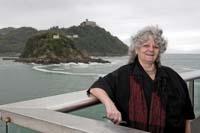"The day I was informed of the Nobel Prize I thought they were taking their hair"

When I started, people asked me why I had to start studying the structure of the ribosomes, why I didn't grab DNA, or messenger RNA… they told me that before I found anything I would die. But I advanced; I wanted to understand the structure of the ribosomes; once understood the structure with precision to know its function.
And yes, there are still many things to investigate. To begin with, we still do not know how all antibiotics work. And it is very important, since half of the antibiotics used in pharmacies and hospitals are antibiotics that affect ribosomes, since they are interrupted. We try to understand their influence on the ribosomes.
Compared to ribosomes, antibiotics are very small elements. On the human scale, it would be like the struggle between David and Goliath. Therefore, to cause damage, the child must avoid or do something similar to the big one. In the ribosomes, antibiotics must interrupt some of the functions necessary for their proper functioning: reading the messenger RNA through the ribosome, advance of protein synthesis, etc.
For example, chloramphenicol occupies the place where the transfer RNA to the ribosome is associated, that is, where the components of proteins, amino acids, and erythromycin are added to the tunnel of the ribosomes. Proteins advance in the central tunnel of the ribosomes as they form and lengthen. Erythromycin is the most effective of the antibiotics that clog the tunnel and is therefore the best. Thus, consumption of 500 mg of another antibiotic four times a day for seven days and 500 mg of erythromycin twice a day for four days. It has been the first time that the structure has explained in science what dose it has taken.
Pathogenic bacteria, however, want to survive, as we want, and develop resistance. They alter their genome to become resistant: they produce proteins that resist antibiotics or alter the "pocket" of the antibiotic (zone of binding of the antibiotic to the ribosome). The bacteria change the atoms of the place where the strongest link is made.
I think the XXI is a resistance. one of the greatest problems of the twentieth century; people can be affected and recovered, while resistances can be eliminated by pneumonia.
Of course! Ribosomes in humans or mammals are 40% higher than those of bacteria. However, sometimes the same processes are given. In the studies we have seen that the active regions of all ribosomes are practically equal. What has changed is the interaction between ribosomes and cells, which has evolved a lot, since animal cells are more complex.
For example, when drinking alcohol we need the alcohol dehydrogenase protein to metabolize that drink. But you don't have to be continually producing alcohol dehydrogenase, because you don't drink constantly. Therefore, ribosoma regulates when and when it does not produce.
Yes. If you give them the messenger [RNA], all ribosomes will fulfill the function of forming the protein. They are totally universal.
On the other hand, among the things we want to know there is another one that I think is very important: we have found a small structure in the complex structure of the ribosome, a nucleus, and we believe that it was formed before living beings emerged.

Yes, and perhaps also the initial structure of life. We are trying to rebuild this structure.
You will forgive me, but I have a standard answer for that question...! [laughter] [laughter]
I was really happy when I first saw the structure of the ribosomes. In particular, twenty years after its commissioning. I started on November 15, 1979 and in September 2000 we published the entire first structure.
During that time I faced the criticism of many people. People did not believe in the structure of the ribosomes and I also advanced very slowly. I needed months to create very small ribosome crystals. Then, when we managed to make measurements with these crystals it also took time: the detectors were not good, we did not put the crystals in the proper position, we damaged the samples... But I continued to work.
Then, the day I was informed of the Nobel Prize, I thought they were taking their hair. He had just returned from a congress from San Sebastian to Tel Aviv. They called me at ten in the morning, from New York, saying that the next day they were going to give me the Nobel Prize in Chemistry.
I thought: "In New York they are three in the morning. These are taking my hair." And I answered what he called to me: "All the night of revelry and you are drinking, go to sleep! ". Therefore, it is clear that he was not willing to receive the prize. Yes, when the next day they asked me if I would accept the prize, I certainly said yes.
No. That is, it was not the most important thing. As everyone was laughing on my own, it was a great Novel award. But many people believe we work to win prizes, and many believe their work is worthy of the prize. In my case, however, my goal was to understand.
I do not know how to answer whether or not he drove the field of the ribosomes; I have seen that yes, he has influenced the young. Children and young people consider the work of scientists as a boring work. I, however, give many lectures to children, and receive letters from children from around the world, from 5-6 to 14-15 years. They ask me for photos, they tell me they want to be like me... One asked me: "Do you present yourself the next year? ". Things like this.
Buletina
Bidali zure helbide elektronikoa eta jaso asteroko buletina zure sarrera-ontzian











